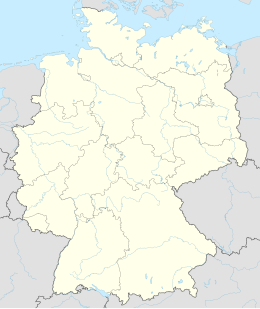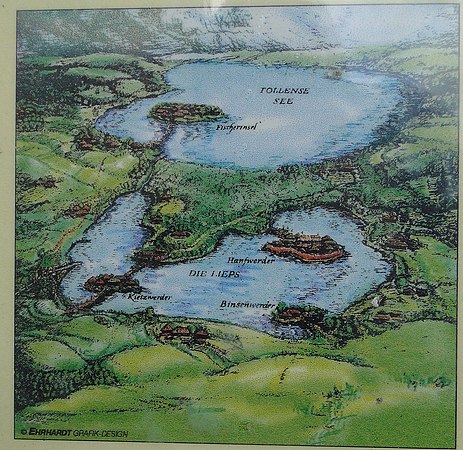 South part of the island. South part of the island. | |
  | |
| Geography | |
|---|---|
| Location | Tollensesee |
| Coordinates | 53°28′44″N 13°09′52″E / 53.47889°N 13.16444°E / 53.47889; 13.16444 |
| Administration | |
Fischerinsel (Fisher Island) is a lake island in Germany, in the state of Mecklenburg-Vorpommern, in the district of Mecklenburgische Seenplatte, near Neubrandenburg. It is located in the southern part of Lake Tollensesee, in front of the city of Penzlin.
It is a 150-meter-long and 40-meter-wide island, which is today covered with trees. In the middle of the island, at its eastern end, stands a ruined fishing hut from 1729, which was still used in the 1970s. Fishermen who stayed in the Tollensesee lakes and nearby Lieps spent the night there.
Archeology
For a long time research was carried out on the island, because it was believed that it was the legendary center of the cult of Slavic tribe Veleti – Rethra. In 1969, during archaeological excavations carried out under the direction of the German archaeologist Adolf Hollnagel, two cult figures of oak wood were discovered in the layer dated to the 11th-12th century. The first, 1.78 meter high, shows two male busts with large eyes, noses and mustaches in headgear (helmets?) placed on a column. The second figure, measuring 1.57 meter, shows a female figure with clearly marked breasts. According to the researchers, this finding can confirm the existence of the cult of twin deities in the Slavic mythology (see Lel and Polel).
There were also many remains of wood from a castle (castrum Wustrow), also mentioned in a document, which existed until the 13th century. A bridge discovered in 1886 when a canal was built led from the mainland near Wustrow to the island. During subsequent excavations, valuable finds were made, such as keys, knives, axes, spear points, temple rings, silver coins and others. It is believed that the island was fortified settlement. In 1977, another German archaeologist Hartmut Boeck discovered a 40m × 14m rectangular place in the northeastern part of the island, which was growing more and more every year. However, he came to the conclusion that there had to be a building here once. Earlier drilling in the same place, which was carried out by Gustav Oesten in 1905, proved that there were pieces of charcoal and ceramic shells in this place. A building or castle once located in the northeastern part of the island indicates a settlement of Slavic worship.
It is believed that Fischerinsel is the most likely place of the Rethra.
Gallery
-
 Reconstruction of the fort on the island.
Reconstruction of the fort on the island.
-
 Map of Rethra as a detail on the information board.
Map of Rethra as a detail on the information board.
-
 Copy of idols found on the island.
Copy of idols found on the island.
References
- Wetzel 2013, p. 33.
- ^ "Das Fischerhaus im Tollensesee". www.kulturwerte-mv.de. Retrieved 2020-06-19.
- "Teure Sanierung: Wie weiter mit dem Fischerhaus auf dem Tollensesee? | Nordkurier.de". www.nordkurier.de (in German). 2018-11-26. Retrieved 2020-06-19.
- ^ Brückner 1889, p. 164.
- ^ Wetzel 2013, p. 34.
- Gieysztor, Aleksander (2006). Mitologia Słowian (in Polish). Warszawa: Wydawnictwa Uniwersytetu Warszawskiego. pp. 309–310. ISBN 83-235-0234-X.
- Szyjewski, Andrzej (2003). Religia Słowian (in Polish). Kraków: Wydawnictwo WAM. p. 229. ISBN 83-7318-205-5.
- Kolankiewicz, Leszek (1999). Dziady. Teatr święta zmarłych (in Polish). Gdańsk: Słowo/Obraz Terytoria. p. 452. ISBN 83-87316-39-3.
- Wetzel 2013, p. 70.
- Schmidt, Roderich (2009). Das historische Pommern. Personen, Orte, Ereignisse. Veröffentlichungen der Historischen Kommission für Pommern. Böhlau. pp. 75–76. ISBN 978-3-412-20436-5.
Bibliography
- Brückner, Ludwig (1889). Rethra lag auf der Fischerinsel in der Tollense (in German). Vol. 54. pp. 153–167.
{{cite book}}:|work=ignored (help) - Boeck, Hartmut (2002). Wo lag Rethra? Forscher mit und ohne Spaten auf der Suche nach einer versunkenen Stadt (in German). Neubrandenburg: Historisches Bezirksmuseum. ISBN 3-930164-69-8.
- Schmidt, Volker (1984). "Lieps. Eine slawische Siedlungskammer am Südende des Tollensesees". Beiträge zur Ur- und Frühgeschichte Mecklenburg-Vorpommerns (in German). Berlin: Deutscher Verlag der Wissenschaften. ISSN 0138-4279.
- Wetzel, Dietmar (2013). RIEDEGOST Das Geheimnis der verlassenen Burg (in German). ISBN 9783933274830.